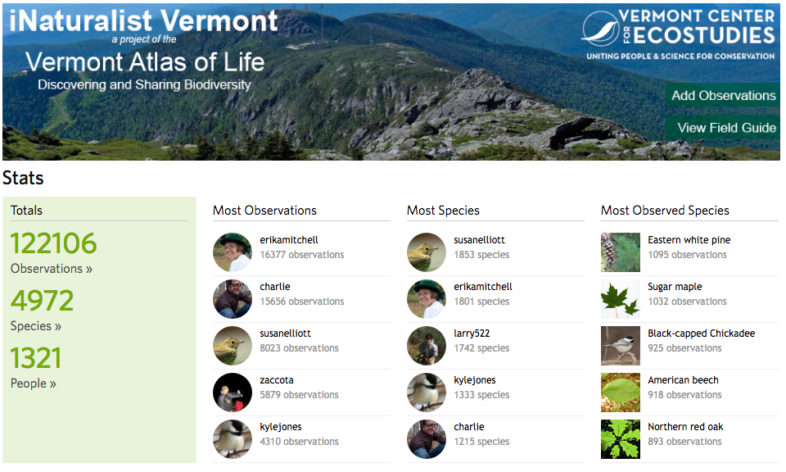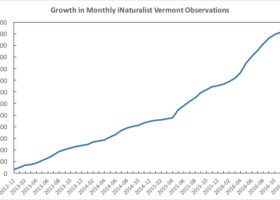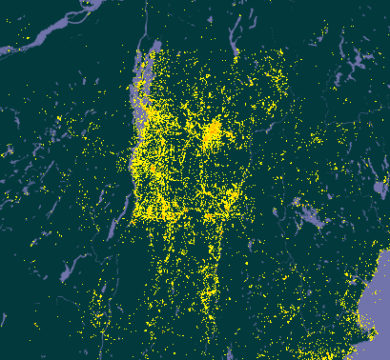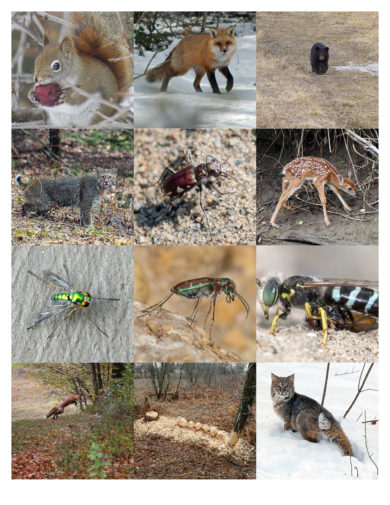With over 122,000 observations of nearly 5,000 species contributed by 1,321 citizen scientists, in just four years iNaturalist Vermont, a project of the Vermont Atlas of Life, has become a big data biodiversity source in the Green Mountain State.
2016 was a big year for iNaturalist Vermont. We had 777 naturalists contribute 43,182 observations for over 3,000 species. Nearly 900 naturalist helped to identify and verify data. Naturalists reported observations from 232 (92%) Vermont towns. And we join the more than 85,000 iNaturalists worldwide that have submitted nearly 3.5 million observations! In 2016 alone, over 1.5 million verifiable observations have been uploaded by over 55,000 users, iNaturalist was featured on NPR, and served as the platform for the National Park Service’s Centennial Bioblitzes, among many other highlights.
iNaturalist Vermont Observations Draw the Map
An observation submitted to iNaturalist becomes what is called ‘research grade’ when it has: a date, has latitude and longitude coordinates, photos or sounds of the observation, and the community agrees on the identification to species level. We have nearly 82,500 research grade observations comprising 3,577 species in the iNaturalist Vermont database. These data are shared continually with the Global Biodiversity Information Facility, an international open data infrastructure that allows anyone, anywhere to access data about all types of life on Earth, shared across national boundaries via the Internet.
Some New and Amazing Discoveries in 2016 from iNaturalist Vermont
As a novice photographer, James Welch enjoys documenting the biodiversity he sees around his home turf. With his camera in hand while walking his dog one June day, Welch stumbled upon a rare find in Vermont near the Winooski River, a Midland Clubtail, and reported it to iNaturalist Vermont. Read the whole story on the VCE Blog.
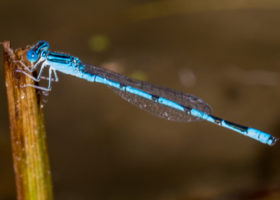
Double-striped Bluet found and photographed by Joshua LIncoln is the first state record for this species in Vermont.
It was a routine warm September day in the field for naturalist Joshua Lincoln. Wandering along the Waterbury Reservoir shoreline, his net was swiping at mostly Darners – recording Lance-tipped, Lake, and Shadow darners with his camera before releasing them. He stalked a pair of Orange Bluet damselflies to photograph. Thirty minutes later, he captured several closeup images of a blue damselfly perched on vegetation, a group that is notoriously hard to identify. Later at home, he discovered that he had found Vermont’s first state record of Double-striped Bluet (Enallagma basidens) and added it to iNaturalist Vermont for the Vermont Damselfly and Dragonfly Atlas at the Vermont Atlas of Life (VAL), where others quickly confirmed his identification.
iNaturalist Vermont shares data with the Vermont Amphibian and Reptile Atlas. Jim Andrews, director of the atlas, noted that iNaturalist Vermont provided dozens of valuable observations for both common and rare species. There were over 30 observations that have helped to fill in distribution voucher gaps for common species. One of the most interesting was a photo and report of the Four-toed Salamander from Bennington County. This is the first report of that species from that county and the only well-documented report from the entire county ever. Although not unexpected, this species is overlooked or misidentified by most people.
There were hundreds of observations of threatened and endangered species, such as the Yellow-Banded Bumblebee (Bombus terricola), from throughout the state, many of these new populations that were not previously known.
Explore the 2016 Photo-Observation of the Month Winners
Each month, iNaturalists ‘fav’ any observation they like to vote for the iNaturalist Vermont photo-observation of the month. Check out these awesome winners from 2016.
We hope you’ll join iNaturalist Vermont and help us make this biodiversity database even stronger. Make iNaturalist Vermont your New Year’s resolution in 2017!
